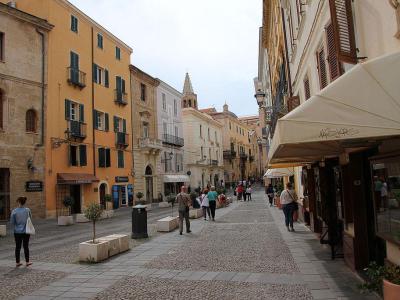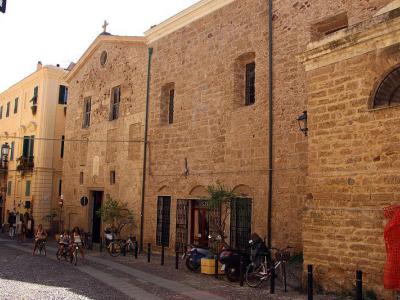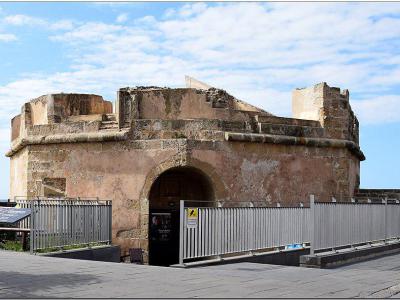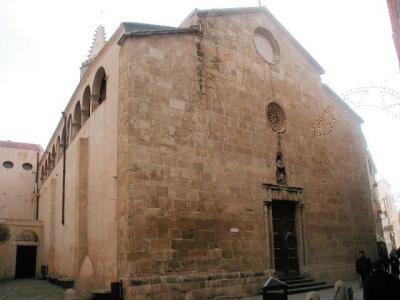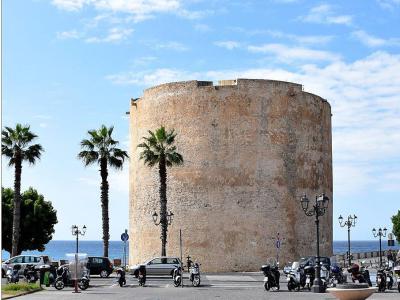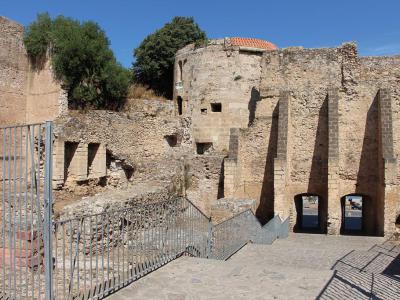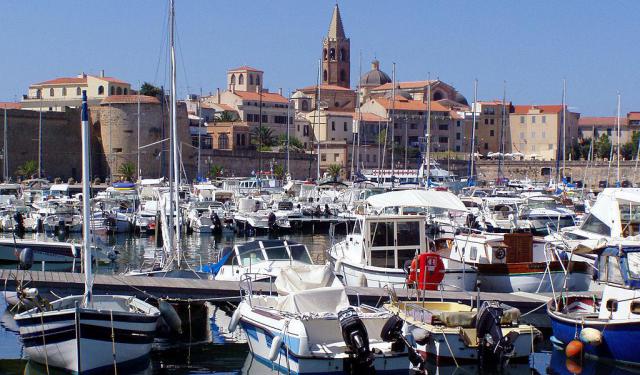
Alghero Introduction Walking Tour (Self Guided), Alghero
Alghero, a charming coastal town in Sardinia, Italy, is a unique historical place where the Sardinian and Catalan cultures united.
The area’s history stretches back way before Christian times. The Phoenicians arrived here in the 8th century BC, establishing a metalworking settlement called Saint Imbenia.
Later, this strategic Mediterranean location attracted the Genoese Doria family, who fortified the town between 1102 and 1112. The name Alghero derives from "Aleguerium," the Latin for "stagnation of algae," which is a seaweed endemic to the Mediterranean Sea.
For the next two centuries, Alghero remained under the influence of the Maritime Republics, except for a brief period of control by Pisa, from 1283 to 1284. In the 14th century, the Crown of Aragon took over the area, encouraging colonization, which ultimately led to the adoption of the Catalan language. Today, Alghero proudly showcases its Catalan roots, evident in the local traditions and architecture.
Following Aragonese rule, the Spanish Habsburgs governed and expanded the town until 1702. In 1720, Alghero was transferred to the House of Savoy, which initiated Italianization policies. During the Fascist era in the 20th century, the surrounding marshes were reclaimed, and new suburbs were established. World War II bombings caused significant damage, but by the 1950s, Alghero evolved into a popular tourist destination.
The heart of Alghero is the Old Town, a captivating maze of cobblestone streets encased within ancient city walls. One of its most striking features is the Civic Square surrounded by impressive historical structures such as the Museum of Sacred Art, which houses a notable collection of ecclesiastical artifacts and artworks.
Nearby, the Cathedral of Saint Virgin Mary is a fine example of Catalan Gothic architecture with Neo-Classical modifications. Another architectural highlight of the Old Town is the elegant Simon Palace.
For those interested in religious architecture, the beautiful Gothic Saint Francis Church and Saint Michael's Church, with its colorful tiled dome, are definite must-sees.
The Bastioni Marco Polo and Sulis Tower offer a glimpse into the town’s defensive past, whereas the Coral Museum showcases Alghero’s long-standing tradition of coral fishing and crafting.
The Central Market is a vibrant spot where you can experience local life and taste fresh Sardinian produce. For relaxation, the Public Gardens provide a serene escape, and the Maddalena Fort adds a historical touch with its panoramic views of the coastline.
Alghero is a unique destination where history, culture, and natural beauty come together. To discover the enchanting allure of this Sardinian gem, take our self-guided tour!
The area’s history stretches back way before Christian times. The Phoenicians arrived here in the 8th century BC, establishing a metalworking settlement called Saint Imbenia.
Later, this strategic Mediterranean location attracted the Genoese Doria family, who fortified the town between 1102 and 1112. The name Alghero derives from "Aleguerium," the Latin for "stagnation of algae," which is a seaweed endemic to the Mediterranean Sea.
For the next two centuries, Alghero remained under the influence of the Maritime Republics, except for a brief period of control by Pisa, from 1283 to 1284. In the 14th century, the Crown of Aragon took over the area, encouraging colonization, which ultimately led to the adoption of the Catalan language. Today, Alghero proudly showcases its Catalan roots, evident in the local traditions and architecture.
Following Aragonese rule, the Spanish Habsburgs governed and expanded the town until 1702. In 1720, Alghero was transferred to the House of Savoy, which initiated Italianization policies. During the Fascist era in the 20th century, the surrounding marshes were reclaimed, and new suburbs were established. World War II bombings caused significant damage, but by the 1950s, Alghero evolved into a popular tourist destination.
The heart of Alghero is the Old Town, a captivating maze of cobblestone streets encased within ancient city walls. One of its most striking features is the Civic Square surrounded by impressive historical structures such as the Museum of Sacred Art, which houses a notable collection of ecclesiastical artifacts and artworks.
Nearby, the Cathedral of Saint Virgin Mary is a fine example of Catalan Gothic architecture with Neo-Classical modifications. Another architectural highlight of the Old Town is the elegant Simon Palace.
For those interested in religious architecture, the beautiful Gothic Saint Francis Church and Saint Michael's Church, with its colorful tiled dome, are definite must-sees.
The Bastioni Marco Polo and Sulis Tower offer a glimpse into the town’s defensive past, whereas the Coral Museum showcases Alghero’s long-standing tradition of coral fishing and crafting.
The Central Market is a vibrant spot where you can experience local life and taste fresh Sardinian produce. For relaxation, the Public Gardens provide a serene escape, and the Maddalena Fort adds a historical touch with its panoramic views of the coastline.
Alghero is a unique destination where history, culture, and natural beauty come together. To discover the enchanting allure of this Sardinian gem, take our self-guided tour!
How it works: Download the app "GPSmyCity: Walks in 1K+ Cities" from Apple App Store or Google Play Store to your mobile phone or tablet. The app turns your mobile device into a personal tour guide and its built-in GPS navigation functions guide you from one tour stop to next. The app works offline, so no data plan is needed when traveling abroad.
Alghero Introduction Walking Tour Map
Guide Name: Alghero Introduction Walking Tour
Guide Location: Italy » Alghero (See other walking tours in Alghero)
Guide Type: Self-guided Walking Tour (Sightseeing)
# of Attractions: 13
Tour Duration: 2 Hour(s)
Travel Distance: 1.6 Km or 1 Miles
Author: Dee
Sight(s) Featured in This Guide:
Guide Location: Italy » Alghero (See other walking tours in Alghero)
Guide Type: Self-guided Walking Tour (Sightseeing)
# of Attractions: 13
Tour Duration: 2 Hour(s)
Travel Distance: 1.6 Km or 1 Miles
Author: Dee
Sight(s) Featured in This Guide:
- Piazza Civica (Civic Square)
- Museo Diocesano d'Arte Sacra ( Museum of Sacred Art)
- Cattedrale di Santa Maria Immacolata (Cathedral of Saint Virgin Mary)
- Bastioni Marco Polo
- Teatro Civico (Civic Theater)
- Chiesa di San Francesco (St. Francis Church)
- Palazzo Simon (Simon Palace)
- Chiesa di San Michele (St. Michael's Church)
- Torre di Sulis (Sulis Tower)
- Coral Museum
- Mercato Centrale (Central Market)
- Giardini Pubblici (Public Gardens)
- Forte della Maddalena (Maddalena Fort)
1) Piazza Civica (Civic Square) (must see)
Civic Square is a prominent and historic square situated near the Port of Alghero. As one of the largest and most significant squares in the city, it serves as a central hub connecting the harbor to the winding streets of the Old Town. The square is historically notable as the site where Holy Roman Emperor Charles V delivered a rousing speech before Sardinian forces embarked to combat the Turks. Today, it remains a vibrant focal point of Alghero’s centro storico.
The square is home to the striking Palazzo d'Albis, formerly the governor’s palace, now hosting the charming Caffè Costantino. This 16th-century café offers a perfect spot to enjoy an espresso or meal while people-watching from its terrace. The Piazza Civica is surrounded by a blend of Spanish and Italian architectural elements, with stone houses featuring tiny wrought-iron balconies and wooden shutters. Walking across its ancient cobblestones, visitors can appreciate the well-preserved historical ambiance.
Adjacent to the square is the Cattedrale di Santa Maria, located just beyond the Piazza Duomo. The cathedral offers a respite from the sun and provides a chance to climb its bell tower for panoramic views of the blue bay and the city’s terra-cotta roofs. The nearby Diocesan Museum of Sacred Art, which remains open into the evening, features an impressive collection of silver relics, wooden sculptures, and religious paintings.
In the evenings, Piazza Civica transforms into a lively space for locals and tourists alike. Enjoy a sweet treat from the gelateria, join the passeggiata—a cherished Italian tradition of an evening stroll—or savor a typical Sardinian meal at one of the local restaurants. With its pedestrian-only access, Piazza Civica is best reached on foot from Porta a Mare, and visitors are advised to explore early or late to avoid the summer crowds and fully experience its historic charm.
The square is home to the striking Palazzo d'Albis, formerly the governor’s palace, now hosting the charming Caffè Costantino. This 16th-century café offers a perfect spot to enjoy an espresso or meal while people-watching from its terrace. The Piazza Civica is surrounded by a blend of Spanish and Italian architectural elements, with stone houses featuring tiny wrought-iron balconies and wooden shutters. Walking across its ancient cobblestones, visitors can appreciate the well-preserved historical ambiance.
Adjacent to the square is the Cattedrale di Santa Maria, located just beyond the Piazza Duomo. The cathedral offers a respite from the sun and provides a chance to climb its bell tower for panoramic views of the blue bay and the city’s terra-cotta roofs. The nearby Diocesan Museum of Sacred Art, which remains open into the evening, features an impressive collection of silver relics, wooden sculptures, and religious paintings.
In the evenings, Piazza Civica transforms into a lively space for locals and tourists alike. Enjoy a sweet treat from the gelateria, join the passeggiata—a cherished Italian tradition of an evening stroll—or savor a typical Sardinian meal at one of the local restaurants. With its pedestrian-only access, Piazza Civica is best reached on foot from Porta a Mare, and visitors are advised to explore early or late to avoid the summer crowds and fully experience its historic charm.
2) Museo Diocesano d'Arte Sacra ( Museum of Sacred Art)
The Diocesean Museum of Sacred Art is a key cultural institution located at the heart of Alghero’s old town. Housed in the former Our Lady of the Rosary Catholic Church, this museum plays a crucial role in preserving and showcasing the artistic and religious heritage of the city. Its collections encompass a rich array of treasures from Alghero’s cathedrals and historic churches, reflecting the deep cultural and spiritual life of the region.
The museum’s exhibits include a diverse range of artifacts such as silverware, wooden sculptures, and paintings. These pieces document the evolution of religious and cultural practices in Alghero over the centuries, offering insight into the artistic ingenuity and devotional traditions of the community. The collection not only highlights the aesthetic qualities of the artworks but also tells the story of how they have shaped and been shaped by the local history.
One of the museum’s significant contributions is its effort to make these treasures accessible to both tourists and locals. The carefully curated displays provide an engaging itinerary that connects visitors with the historical and cultural fabric of Alghero. Through its exhibits, the museum offers a window into the religious and artistic heritage that has influenced not only Alghero but also the broader Mediterranean region.
The museum’s exhibits include a diverse range of artifacts such as silverware, wooden sculptures, and paintings. These pieces document the evolution of religious and cultural practices in Alghero over the centuries, offering insight into the artistic ingenuity and devotional traditions of the community. The collection not only highlights the aesthetic qualities of the artworks but also tells the story of how they have shaped and been shaped by the local history.
One of the museum’s significant contributions is its effort to make these treasures accessible to both tourists and locals. The carefully curated displays provide an engaging itinerary that connects visitors with the historical and cultural fabric of Alghero. Through its exhibits, the museum offers a window into the religious and artistic heritage that has influenced not only Alghero but also the broader Mediterranean region.
3) Cattedrale di Santa Maria Immacolata (Cathedral of Saint Virgin Mary) (must see)
The Cathedral of Saint Virgin Mary is a significant Roman Catholic cathedral. Serving as the episcopal seat since 1503, the cathedral's long and complex construction reflects its historical and architectural evolution. The site was designated as a diocesan seat in 1503, but actual construction did not commence until the 1530s. It took over 60 years to open, and the cathedral was not fully completed and consecrated until 1730.
Originally built in a Catalan-Gothic style, the cathedral features several architectural elements from this period, including the five chapels and ambulatory of the presbytery, as well as the octagonal base of the bell tower. However, the nave and the two aisles were constructed in the Late Renaissance style, showing a transition in architectural trends during the cathedral's lengthy building process. This blend of styles adds to the building's historical richness and visual interest.
In the 19th century, a Neo-Classical narthex was added to the cathedral’s facade, dramatically altering its appearance and adding a new layer of architectural complexity. The cathedral also serves as a burial site for notable figures, including the Italian Duke of Montferrat and his brother, who died on the island of malaria in the late 18th century.
Today, the Cathedral of Saint Virgin Mary stands not only as a place of worship but also as a monument to the diverse architectural styles and historical phases that have shaped Alghero.
Originally built in a Catalan-Gothic style, the cathedral features several architectural elements from this period, including the five chapels and ambulatory of the presbytery, as well as the octagonal base of the bell tower. However, the nave and the two aisles were constructed in the Late Renaissance style, showing a transition in architectural trends during the cathedral's lengthy building process. This blend of styles adds to the building's historical richness and visual interest.
In the 19th century, a Neo-Classical narthex was added to the cathedral’s facade, dramatically altering its appearance and adding a new layer of architectural complexity. The cathedral also serves as a burial site for notable figures, including the Italian Duke of Montferrat and his brother, who died on the island of malaria in the late 18th century.
Today, the Cathedral of Saint Virgin Mary stands not only as a place of worship but also as a monument to the diverse architectural styles and historical phases that have shaped Alghero.
4) Bastioni Marco Polo
The Marco Polo Bastion is a prominent feature of Alghero’s historic fortifications and one of the city's few remaining intact bastions. Alghero, known for its well-preserved medieval walls and towers, has dedicated several of these defensive structures to great explorers, including Marco Polo, Christopher Columbus, and Ferdinand Magellan. The Marco Polo Bastion stands between the Tower of Saint James (Torre di San Giacomo) and the Bastioni Cristoforo Colombo, forming a critical part of the city's defensive perimeter.
Originally constructed as part of Alghero’s fortifications, the Bastioni Marco Polo has undergone significant renovation to restore its historical splendor. The renovation has transformed the bastion into a popular destination for both locals and tourists, offering stunning views of the surrounding landscape. The bastion's elevated position provides an excellent vantage point to enjoy picturesque sunsets over the city and the Mediterranean Sea, making it a favored spot for photography and relaxation.
The area around the Marco Polo Bastion is vibrant with numerous restaurants and bars, adding to its appeal as a social and cultural hotspot. These establishments not only offer a chance to savor local cuisine but also enhance the bastion’s role as a gathering place, where visitors can soak in the atmosphere of this historic setting while enjoying refreshments.
Originally constructed as part of Alghero’s fortifications, the Bastioni Marco Polo has undergone significant renovation to restore its historical splendor. The renovation has transformed the bastion into a popular destination for both locals and tourists, offering stunning views of the surrounding landscape. The bastion's elevated position provides an excellent vantage point to enjoy picturesque sunsets over the city and the Mediterranean Sea, making it a favored spot for photography and relaxation.
The area around the Marco Polo Bastion is vibrant with numerous restaurants and bars, adding to its appeal as a social and cultural hotspot. These establishments not only offer a chance to savor local cuisine but also enhance the bastion’s role as a gathering place, where visitors can soak in the atmosphere of this historic setting while enjoying refreshments.
5) Teatro Civico (Civic Theater)
The Civic Theater is a cherished cultural landmark situated in the heart of Sardinian Square in Alghero. Designed by architect Franco Poggi, construction of the theater began in 1829 and was completed in 1862. Since then, it has undergone several renovations, with the most recent restoration occurring in 2004. Despite these updates, the theater has meticulously preserved Poggi's original design, ensuring that the stage and auditorium remain true to their historical roots.
The Civic Theater is renowned for its Neoclassical interior, characterized by its elegant and ornate decorations. The stage, framed by intricate detailing, serves as a focal point of the theater's grandeur. The theater's design reflects the sophisticated tastes of the 19th century, with its plush seating and decorative features creating a regal atmosphere that enhances the audience's experience.
As one of Alghero’s most prominent venues, the Civic Theater plays a central role in the city’s cultural life. It hosts a wide array of artistic events, from theatrical performances and operas to music concerts and dance recitals. The theater’s debut performance was the opera "Lucia di Lammermoor" by Gaetano Donizetti, marking the beginning of its long-standing tradition of showcasing high-quality performances.
The Civic Theater is renowned for its Neoclassical interior, characterized by its elegant and ornate decorations. The stage, framed by intricate detailing, serves as a focal point of the theater's grandeur. The theater's design reflects the sophisticated tastes of the 19th century, with its plush seating and decorative features creating a regal atmosphere that enhances the audience's experience.
As one of Alghero’s most prominent venues, the Civic Theater plays a central role in the city’s cultural life. It hosts a wide array of artistic events, from theatrical performances and operas to music concerts and dance recitals. The theater’s debut performance was the opera "Lucia di Lammermoor" by Gaetano Donizetti, marking the beginning of its long-standing tradition of showcasing high-quality performances.
6) Chiesa di San Francesco (St. Francis Church) (must see)
Saint Francis Church is a captivating historical landmark nestled in Alghero's atmospheric Old Town. Originally constructed in the 1300s, this church complex is a rich tapestry of architectural styles, blending Romanesque, Catalan-Gothic, late Renaissance, and Baroque influences. Its restoration in the 14th century has preserved its intricate historical details, making it one of the finest examples of Gothic-Catalan architecture in Sardinia.
The church complex includes a serene two-tiered cloister, which is the oldest part of the building. This tranquil space, located in the heart of the main shopping district on Via Carlo Alberto, features charming arches and is used as a venue for summer concerts. The cloister’s design is characterized by its elegant arches and historic murals, which date back to 1360 and were later rebuilt in the late 16th century.
The small chapel at the base of the tower provides a serene retreat, while the main church exhibits a blend of Gothic-Catalan elements over the high altar, the presbytery chapels, and the San Sacramento Chapel. The stone building is further distinguished by its bell tower from the first half of the 16th century and a facade adorned with a classic-style lintel, featuring the emblem of the Franciscans encircled by angels.
The church complex includes a serene two-tiered cloister, which is the oldest part of the building. This tranquil space, located in the heart of the main shopping district on Via Carlo Alberto, features charming arches and is used as a venue for summer concerts. The cloister’s design is characterized by its elegant arches and historic murals, which date back to 1360 and were later rebuilt in the late 16th century.
The small chapel at the base of the tower provides a serene retreat, while the main church exhibits a blend of Gothic-Catalan elements over the high altar, the presbytery chapels, and the San Sacramento Chapel. The stone building is further distinguished by its bell tower from the first half of the 16th century and a facade adorned with a classic-style lintel, featuring the emblem of the Franciscans encircled by angels.
7) Palazzo Simon (Simon Palace)
Simon Palace stands prominently on Gilbert Ferret Street in Alghero, near the historic San Giovanni Tower. Originally constructed in the late 13th century, this elegant building has undergone significant restoration, particularly in the late 19th century. Its architectural design reflects the Neoclassical style, characterized by clean lines, grand proportions, and classical detailing.
The façade of Simon Palace is distinguished by a massive front door framed by a gracefully arching entrance. Above this door, the emblem of the Simon family, the palace's original owners, is prominently displayed. This emblem adds a touch of historical significance and personal connection to the building's past.
The Neoclassical design of Simon Palace is evident in its symmetrical layout and refined ornamentation, which are hallmarks of the style. The building's restoration has preserved these elements, ensuring that the palace remains a striking example of architectural elegance.
Today, Simon Palace is a notable feature of Alghero's historic streetscape, offering a glimpse into the city's rich architectural and familial heritage. Its prominent location and historical significance make it an important landmark for both visitors and locals alike.
The façade of Simon Palace is distinguished by a massive front door framed by a gracefully arching entrance. Above this door, the emblem of the Simon family, the palace's original owners, is prominently displayed. This emblem adds a touch of historical significance and personal connection to the building's past.
The Neoclassical design of Simon Palace is evident in its symmetrical layout and refined ornamentation, which are hallmarks of the style. The building's restoration has preserved these elements, ensuring that the palace remains a striking example of architectural elegance.
Today, Simon Palace is a notable feature of Alghero's historic streetscape, offering a glimpse into the city's rich architectural and familial heritage. Its prominent location and historical significance make it an important landmark for both visitors and locals alike.
8) Chiesa di San Michele (St. Michael's Church) (must see)
Saint Michael’s Church is a standout example of Baroque architecture in Sardinia, distinguished by its vibrant and intricately tiled dome. Located on Via Carlo Alberto, the main thoroughfare in Alghero's historic center, this 17th-century church is a testament to the island's Catalan influences, evident in its colorful maiolica-tiled dome.
The church's construction began in the late 16th century, and despite Alghero being designated a diocesan seat in 1503, it was not until 1593 that the church opened its doors. The exterior is highlighted by a plinth of squared blocks, contributing to its impressive Baroque façade. Although the current tiles were added in the 1960s, they maintain the striking aesthetic for which the church is renowned.
Inside, Saint Michael’s Church houses a notable wooden sculpture of St. Michael vanquishing Satan, a central feature that adds to the church's historical and artistic significance. The interior reflects the grandeur of Baroque design, offering a captivating contrast to the colorful exterior.
Adjacent to the church is the intersection of Via Carlo Alberto and Via Gilbert Ferret, known as the quatre cantonades. Historically, this area was a gathering spot for laborers seeking work, adding a layer of cultural context to the church's rich history.
The church's construction began in the late 16th century, and despite Alghero being designated a diocesan seat in 1503, it was not until 1593 that the church opened its doors. The exterior is highlighted by a plinth of squared blocks, contributing to its impressive Baroque façade. Although the current tiles were added in the 1960s, they maintain the striking aesthetic for which the church is renowned.
Inside, Saint Michael’s Church houses a notable wooden sculpture of St. Michael vanquishing Satan, a central feature that adds to the church's historical and artistic significance. The interior reflects the grandeur of Baroque design, offering a captivating contrast to the colorful exterior.
Adjacent to the church is the intersection of Via Carlo Alberto and Via Gilbert Ferret, known as the quatre cantonades. Historically, this area was a gathering spot for laborers seeking work, adding a layer of cultural context to the church's rich history.
9) Torre di Sulis (Sulis Tower)
Sulis Tower is a striking landmark that stands proudly in Piazza Sulis, a central square in Alghero. Built in the first half of the 16th century, this imposing tower was originally one of the key bastions of the city's fortifications. Its robust design, featuring walls up to 6 meters thick, highlights its defensive purpose and architectural grandeur.
The tower’s current name pays homage to Vincenzo Sulis, a 19th-century Sardinian revolutionary who endured 22 years of solitary confinement within its formidable walls. This dark chapter of its history adds a layer of poignant significance to the tower, linking it to the broader historical narrative of resistance and resilience in Sardinia.
Sulis Tower was once one of the most majestic towers in Alghero, part of a network of fortifications that protected the city. Its strategic location and robust construction reflect its role in the defense of Alghero during the turbulent periods of the 16th century.
Today, Sulis Tower stands as a prominent historical monument, attracting visitors interested in its rich past and its connection to both local and broader historical events.
The tower’s current name pays homage to Vincenzo Sulis, a 19th-century Sardinian revolutionary who endured 22 years of solitary confinement within its formidable walls. This dark chapter of its history adds a layer of poignant significance to the tower, linking it to the broader historical narrative of resistance and resilience in Sardinia.
Sulis Tower was once one of the most majestic towers in Alghero, part of a network of fortifications that protected the city. Its strategic location and robust construction reflect its role in the defense of Alghero during the turbulent periods of the 16th century.
Today, Sulis Tower stands as a prominent historical monument, attracting visitors interested in its rich past and its connection to both local and broader historical events.
10) Coral Museum
The Coral Museum offers a fascinating exploration of one of the city's most celebrated natural treasures: corallium rubrum, or red coral. Located in the elegant Art Deco Villa Costantino, built in 1927, the museum is situated just outside the city walls, near the remnants of the old bastions. This charming villa, named after the family who constructed it, provides an ideal setting for showcasing Alghero's rich coral heritage.
The museum's exhibitions, completely renovated in 2016, delve into the cultural, historical, and economic significance of red coral. The displays highlight how this precious material, often referred to as ‘red gold,’ has influenced Alghero’s identity and contributed to its fame and fortune. Visitors can learn about the scientific aspects of coral, its role in local traditions, and its impact on the region’s economy.
In addition to its informative panels, the museum features a variety of coral artworks, including intricate pieces of jewelry crafted by local artisans. These exhibits not only display the skill of Alghero's coral craftsmen but also illustrate the evolution of coral harvesting practices over the years. The museum’s Liberty-style architecture complements the theme of the exhibits, creating a cohesive and immersive experience.
The museum's exhibitions, completely renovated in 2016, delve into the cultural, historical, and economic significance of red coral. The displays highlight how this precious material, often referred to as ‘red gold,’ has influenced Alghero’s identity and contributed to its fame and fortune. Visitors can learn about the scientific aspects of coral, its role in local traditions, and its impact on the region’s economy.
In addition to its informative panels, the museum features a variety of coral artworks, including intricate pieces of jewelry crafted by local artisans. These exhibits not only display the skill of Alghero's coral craftsmen but also illustrate the evolution of coral harvesting practices over the years. The museum’s Liberty-style architecture complements the theme of the exhibits, creating a cohesive and immersive experience.
11) Mercato Centrale (Central Market)
The Central Market offers a vibrant and immersive food experience, deeply rooted in local traditions and culinary practices. Located just a short stroll from Torre di San Giovanni, this market is a cherished hub for both residents and visitors, where the essence of Sardinian cuisine comes to life.
In the Central Market, food is not merely sold; it is celebrated and shared. The market is a testament to the craftsmanship of local artisans who possess a profound respect for their ingredients. Here, visitors can find a diverse array of fresh produce, including meat, fish, fruits, and vegetables, each reflecting the quality and authenticity of Sardinian fare. The market's layout fosters an atmosphere of community and spontaneity, allowing shoppers to engage with vendors and experience the rich flavors and aromas of the region.
The Central Market is more than just a shopping destination; it is a cultural and social landmark. It serves as a gathering place where people come together to exchange stories, learn about traditional recipes, and enjoy the simple pleasures of good food. The market's dynamic environment embodies the spirit of Alghero, offering a genuine glimpse into the local way of life.
As you wander through Central Market, you'll encounter a blend of tradition and modernity. The market stands as a living tribute to the art of food preparation and the importance of community, making it a must-visit for anyone seeking to understand the heart of Alghero’s culinary heritage.
In the Central Market, food is not merely sold; it is celebrated and shared. The market is a testament to the craftsmanship of local artisans who possess a profound respect for their ingredients. Here, visitors can find a diverse array of fresh produce, including meat, fish, fruits, and vegetables, each reflecting the quality and authenticity of Sardinian fare. The market's layout fosters an atmosphere of community and spontaneity, allowing shoppers to engage with vendors and experience the rich flavors and aromas of the region.
The Central Market is more than just a shopping destination; it is a cultural and social landmark. It serves as a gathering place where people come together to exchange stories, learn about traditional recipes, and enjoy the simple pleasures of good food. The market's dynamic environment embodies the spirit of Alghero, offering a genuine glimpse into the local way of life.
As you wander through Central Market, you'll encounter a blend of tradition and modernity. The market stands as a living tribute to the art of food preparation and the importance of community, making it a must-visit for anyone seeking to understand the heart of Alghero’s culinary heritage.
12) Giardini Pubblici (Public Gardens)
Alghero’s Public Gardens, situated near Maddalena Fort, offer a serene escape from the bustling city streets. Created in the 19th century, this verdant park was established when the city's defensive walls were removed, effectively bridging the gap between the medieval center and the modern new town. The gardens are now a cherished space where locals and visitors alike come to relax and enjoy the beauty of nature.
The park’s lush landscapes are a visual delight, featuring a diverse array of plants and trees that change with the seasons. It’s a popular spot for leisurely strolls, offering a peaceful retreat from the city's hustle and bustle. As you wander through the gardens, you’ll encounter well-maintained paths that wind past vibrant flowerbeds and shady groves, making it an ideal place for a tranquil afternoon.
The Public Gardens are also home to several important monuments, each adding a layer of historical and cultural significance to the park. Notable landmarks include the Unitat de la Lengua, a tribute to the Catalan language and culture, the Giuseppe Manno monument honoring the Sardinian writer and politician, and the War Memorial, which commemorates those who served in conflicts. These monuments provide a connection to Alghero’s rich history and offer visitors insights into the city's past.
The park’s lush landscapes are a visual delight, featuring a diverse array of plants and trees that change with the seasons. It’s a popular spot for leisurely strolls, offering a peaceful retreat from the city's hustle and bustle. As you wander through the gardens, you’ll encounter well-maintained paths that wind past vibrant flowerbeds and shady groves, making it an ideal place for a tranquil afternoon.
The Public Gardens are also home to several important monuments, each adding a layer of historical and cultural significance to the park. Notable landmarks include the Unitat de la Lengua, a tribute to the Catalan language and culture, the Giuseppe Manno monument honoring the Sardinian writer and politician, and the War Memorial, which commemorates those who served in conflicts. These monuments provide a connection to Alghero’s rich history and offer visitors insights into the city's past.
13) Forte della Maddalena (Maddalena Fort)
Maddalena Fort stands as a historic sentinel to the north of Alghero’s old town. Constructed at the end of the 16th century, it is the sole survivor of three forts built to strengthen the city's land defenses. The fort's central tower, known as the Torre della Maddalena or Torre di Garibaldi, has medieval origins, adding a layer of historical depth to the structure.
The fort was originally dedicated to Mary Magdalene, a dedication that is still reflected in the presence of a statue of her at the site. However, the statue is now largely unrecognizable, having been eroded by the passage of time. Despite its weathered state, the fort continues to hold historical significance as a reminder of Alghero’s strategic military past.
In recent years, Forte della Maddalena has been repurposed as a cultural venue, hosting a variety of events throughout the summer months. Its picturesque setting makes it an ideal location for jazz festivals and outdoor classical music concerts, drawing both locals and visitors to its historic walls. The fort's transformation from a defensive stronghold to a vibrant cultural space reflects Alghero's evolving appreciation of its historical landmarks.
The fort was originally dedicated to Mary Magdalene, a dedication that is still reflected in the presence of a statue of her at the site. However, the statue is now largely unrecognizable, having been eroded by the passage of time. Despite its weathered state, the fort continues to hold historical significance as a reminder of Alghero’s strategic military past.
In recent years, Forte della Maddalena has been repurposed as a cultural venue, hosting a variety of events throughout the summer months. Its picturesque setting makes it an ideal location for jazz festivals and outdoor classical music concerts, drawing both locals and visitors to its historic walls. The fort's transformation from a defensive stronghold to a vibrant cultural space reflects Alghero's evolving appreciation of its historical landmarks.
Walking Tours in Alghero, Italy
Create Your Own Walk in Alghero
Creating your own self-guided walk in Alghero is easy and fun. Choose the city attractions that you want to see and a walk route map will be created just for you. You can even set your hotel as the start point of the walk.
Alghero's Old Palaces
Alghero, a historical gem on the northwest coast of Sardinia, is home to some of Italy's most significant architectural monuments. This is evident in the city's remarkable collection of old palaces, showcasing narratives that span centuries.
Carcassona Palace, dating back to the mid-1400s, stands out with its mix of influences from Valencia, Naples, Palermo, and Sardinia. A former... view more
Tour Duration: 1 Hour(s)
Travel Distance: 1.0 Km or 0.6 Miles
Carcassona Palace, dating back to the mid-1400s, stands out with its mix of influences from Valencia, Naples, Palermo, and Sardinia. A former... view more
Tour Duration: 1 Hour(s)
Travel Distance: 1.0 Km or 0.6 Miles
The Most Popular Cities
/ view all
